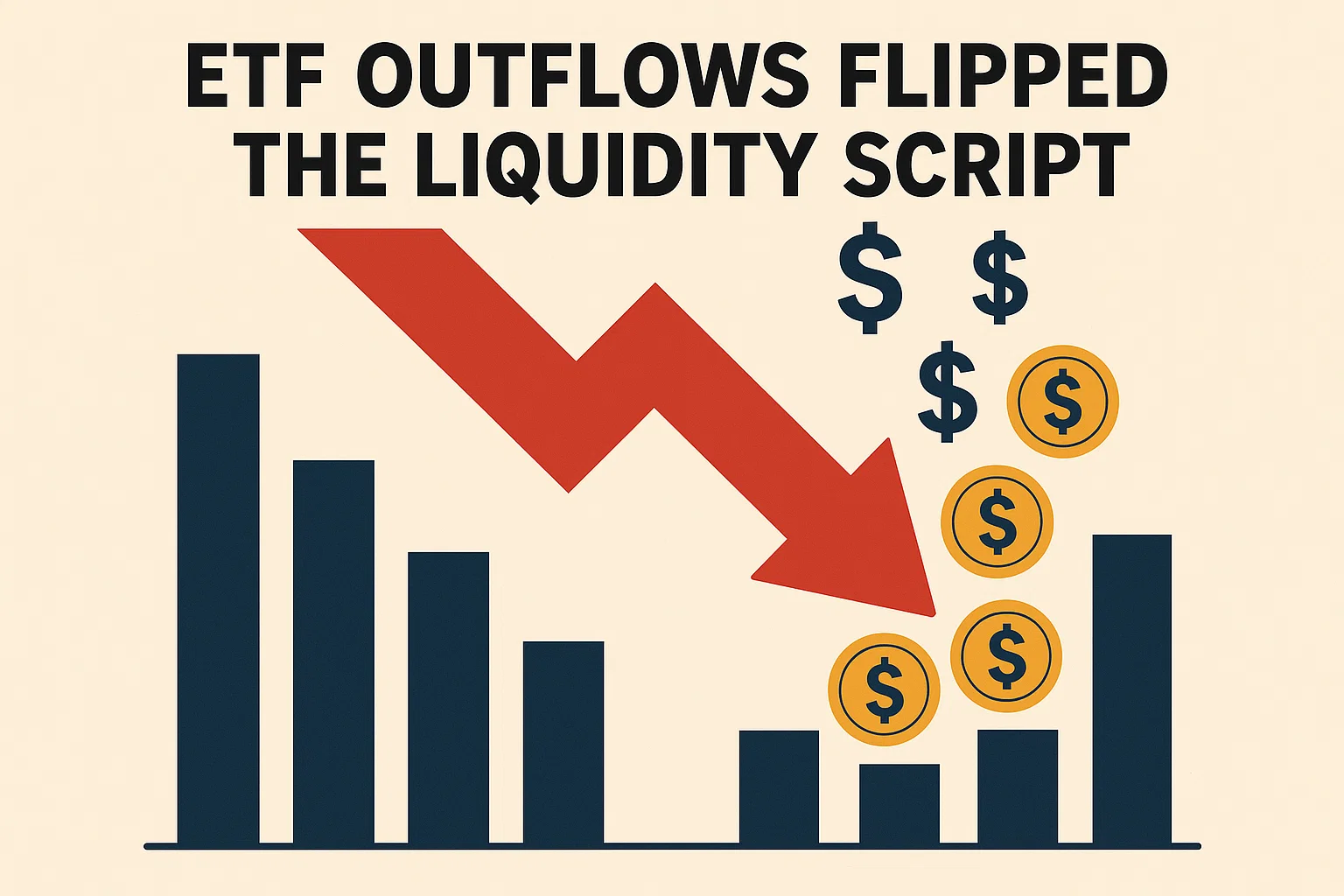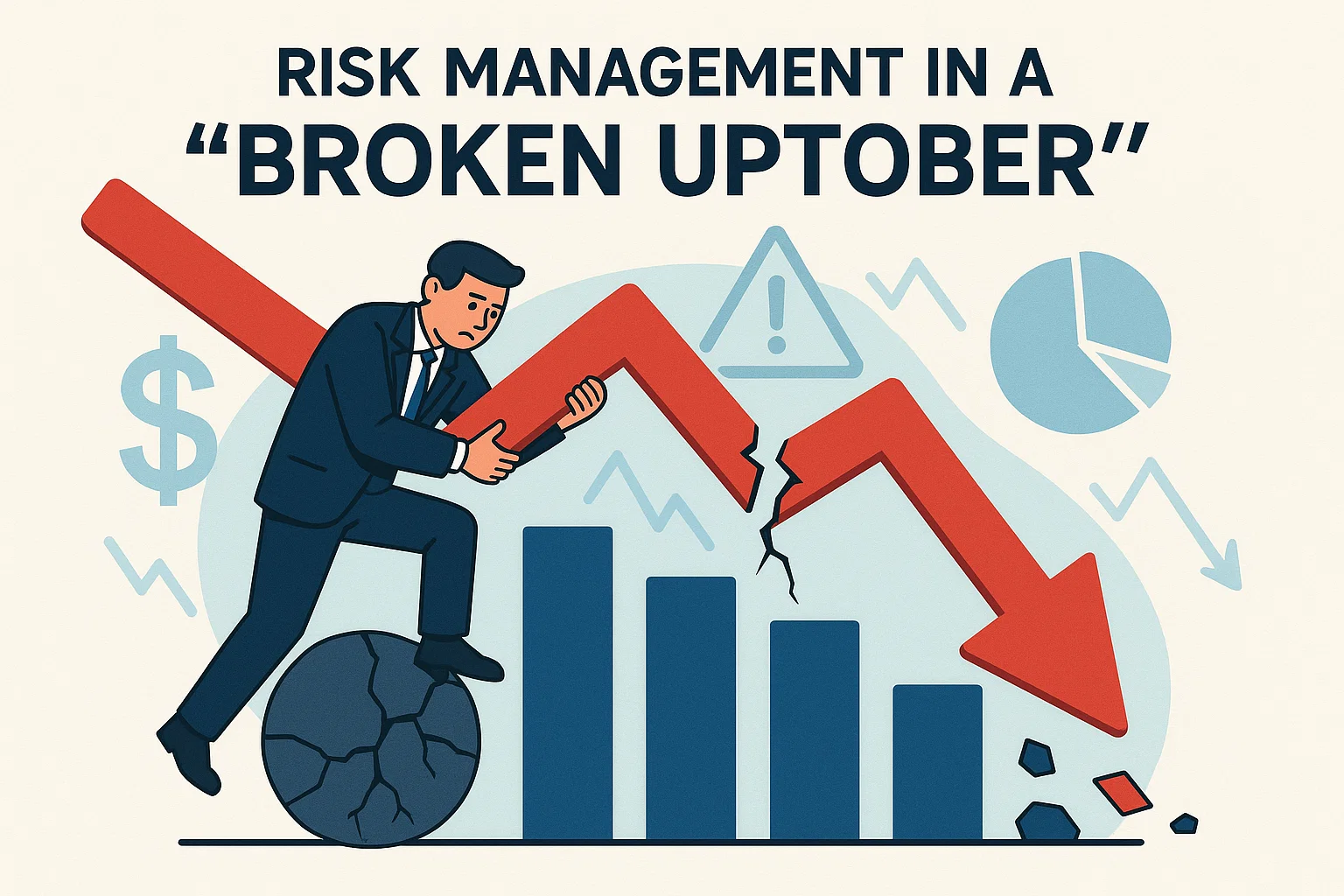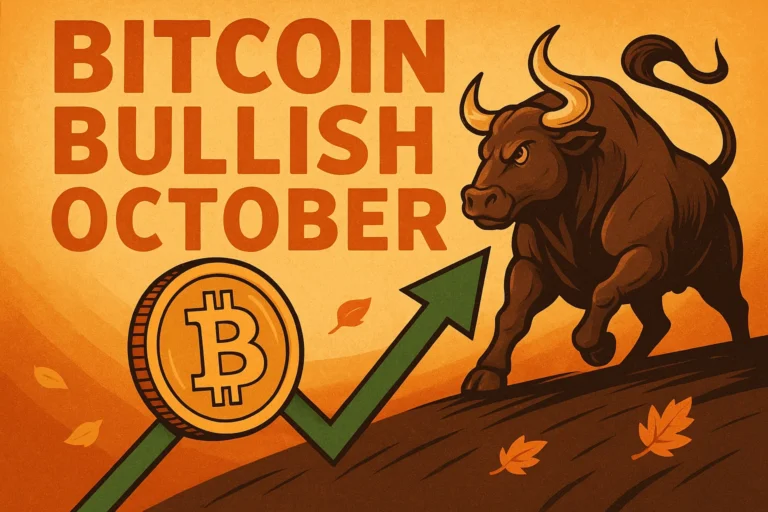Bitcoin Bullish October crypto bull knows the mantra: “Uptober.” Historically, October has been one of Bitcoin’s most favorable months, a seasonal sweet spot that often launches year-end rallies. This year is different. Midway through October 2025, Bitcoin has struggled to hold key levels, briefly sinking toward three-month lows as macro shockwaves, spot Bitcoin ETF outflows, and heightened geopolitical risk sap risk appetite. The result is a jarring contrast with October’s reputation—and a growing possibility that October 2025 could finish as Bitcoin’s worst October in a decade. CoinDesk notes the month-to-date return has flipped negative, at roughly a mid-single-digit decline as of October 19, versus an average October gain near 20% historically, a striking break from form.
Understanding what changed—and what typically makes October strong—can help traders navigate the rest of the month and position for November, which has historically been even better for BTC. In this deep dive, we’ll unpack the drivers behind October’s stumble, explore the role of ETF flows, macro headwinds, and derivatives positioning, and assess scenarios that could still rescue “Uptober” before month-end.
Why October Is Usually “Uptober”
“Uptober” isn’t just a meme. Since 2013, October has consistently ranked among Bitcoin’s strongest months, with double-digit average gains and a high hit rate of positive finishes. Data providers that track monthly return dashboards show October’s performance has repeatedly outpaced most other months, contributing to the community’s upbeat expectations as Q4 begins. CoinDesk summarizes this seasonality by citing an average October return of around 19.8%, second only to November’s powerful track record. CoinGlass’ historical dashboards likewise reflect the tendency for October to close green more often than not.
That strength typically stems from a blend of factors: improved risk sentiment heading into year-end, portfolio rotations as funds chase performance, and momentum spillovers from traditional markets. In bull cycles, Bitcoin often treats October as a springboard, with positive seasonality feeding into November’s historically robust returns.
What’s Different in October 2025
The seasonality signal is breaking down
Seasonality is a tendency, not a guarantee. This October, Bitcoin entered the month near elevated levels after a scorching summer that pushed prices back toward all-time highs. When the macro backdrop turned volatile, the market was vulnerable. By mid-October, BTC had dropped to roughly three-month lows, with broad crypto selling pressuring majors and high-beta altcoins even more. Barron’s captured the shift as Bitcoin slid to around the low-$100k area (its lowest since June), highlighting a classic risk-off flush.
ETF outflows flipped the liquidity script
Bitcoin Bullish October story of 2025—especially after the successful rollout of spot Bitcoin ETFs—has been one of flows. Inflows can become a rising tide; outflows can pull the tide back out. On October 17, U.S. spot Bitcoin ETFs recorded more than $500 million in net outflows, the largest daily redemption since August. That reversal coincided with BTC’s descent below key round numbers and signaled a short-term demand vacuum just when the market needed a stabilizing bid.

ETF flows matter beyond immediate buying power. They influence derivatives positioning, dealer hedging, and sentiment around Bitcoin as an investable macro asset. When outflows surge, the liquidity profile worsens, and volatility often rises as market makers and leveraged traders rebalance.
Macro turned hostile—fast
Crypto doesn’t trade in a vacuum. Renewed trade tensions, banking worries, and sharp risk-off episodes across global equities have weighed on risk assets broadly, crypto included. Reuters reported a mid-October selloff across primary or tokens as U.S.–China tensions escalated, a reminder that geopolitical stress compresses risk budgets and encourages de-leveraging. Barron’s similarly noted a simultaneous downdraft in equities and crypto as volatility spiked.
In risk-off regimes, correlations between Bitcoin and equity indices can tighten, especially when the driver is a macro shock rather than a crypto-native event. The same headwinds that hit high beta tech—rising uncertainty, tighter financial conditions, earnings jitters—tend to hit BTC as well.
The Data Behind “Worst in 10 Years”
The claim that October 2025 is on track to be Bitcoin’s worst October in a decade comes straight from current month-to-date returns stacked against historical averages. As of October 19, CoinDesk reported Bitcoin down about 5% for October, in stark contrast to the ~19.8% historical average gain, and the poorest October trajectory since 2015. The comparison is particularly startling because October’s reputation is so strong that even a flat finish would be below par; a meaningful decline would be downright rare for this month.
The implication isn’t merely semantic. Seasonality-driven strategies that pre-position for October strength have faced drawdowns this time, and passive inflow expectations from ETFs have been challenged. If “Uptober” falters, it can reshape expectations for November as well—even though November’s performance profile remains historically powerful.
What Derailed Uptober? A Closer Look at the Catalysts
The ETF flow flip
Through much of 2025, spot Bitcoin ETF inflows served as a persistent demand tailwind, smoothing dips and fueling rallies. October’s abrupt net outflows—over $500 million in a single day—signaled a break in that feedback loop. When ETF flows sour, it removes a structural buyer from the tape, especially during U.S. market hours when flows are tallied and market makers hedge. A few sessions of sustained outflows can cascade into thinner liquidity, wider spreads, and sharper moves as participants reduce risk.
Macro shocks and correlation spikes
Macro tremors—trade frictions, banking stress headlines, and growth fears—pushed equities and Bitcoin lower in sync. In such periods, the “digital gold” narrative takes a back seat to liquidity realities; when funds sell what they can sell, BTC is liquid enough to be a source of cash. Reuters and Barron’s coverage of the mid-October downdraft captured how quickly crypto can track broader risk sentiment when the dominant driver is exogenous to the blockchain economy.
Derivatives positioning added fuel
October’s slide also intersected with a buildup in leverage earlier in the quarter. When prices knifed lower, forced de-risking and liquidations amplified the downside. While headlines varied on the exact tally, the dynamic is familiar: once key levels break, automated selling from liquidations and stop-losses can produce waterfall moves, flattening order books and shaking confidence. That reflex loop is a staple of Bitcoin market microstructure—especially when ETF outflows and macro stress hit simultaneously.
Sentiment whiplash
“Uptober” front-runs optimism. When that optimism flips to anxiety, fear can spread quickly. Anecdotal measures—social chatter, funding rate snapbacks, and a swift drop in risk-taking by altcoin traders—echoed the change in tone. The market slid from “buy-the-dip” bravado to “protect-the-book” caution within days.
Technical Context: The Levels That Matter
Technically, October’s pullback forced Bitcoin to defend areas that bulls previously treated as launchpads. The inability to hold above psychologically critical round numbers signaled waning momentum. A brief breach toward three-month lows spooked shorter-term participants, particularly those who bought the early-October pop expecting a glide path into year-end. Barron’s highlighted the violation of trend gauges like the 200-day moving average, which, if sustained, can tilt swing-trader playbooks from buy-the-dip to sell-the-rip.
For seasoned traders, the immediate focus is reclaimed levels and whether the market can establish a higher low. If that process fails, the path of least resistance remains choppy and range-bound, punctuated by event risk from macro headlines and ETF flow prints.
Fundamentals and Flows What Could Save October
The case for a late-month rescue
Despite the gloomy start, two forces could still rescue “Uptober” before the calendar flips:
A flow reversal in spot Bitcoin ETFs. If outflows stabilize and turn into net inflows, Bitcoin could rebuild a steady bid. In 2025, the flow impulse has repeatedly set the tone for the cash market and for derivatives hedging. A few intense sessions can restore confidence and reduce realized volatility. CoinDesk’s coverage of the outflow spike shows how pivotal the ETF complex has become; the reverse is also true when inflows return.
Macro relief and risk-on rotation. The other lever is a thaw in macro stress—cooler trade rhetoric, calmer banking headlines, or a more straightforward path for central-bank policy. When risk assets stabilize, Bitcoin typically benefits from renewed liquidity and higher beta participation. Reuters’ and Barron’s reports underscore the connection between broad risk tone and crypto beta. A friendlier tape in equities can unshackle BTC from defensive flows.
Seasonality still favors if conditions calm..
Even if October finishes weak, November’s historical strength shouldn’t be ignored. October’s long-run average of ~+20% and November’s even stronger track record speak to a well-known pattern: when macro cooperates, Q4 can be generous. CoinDesk’s October and November averages are a reminder that seasonality is powerful—but conditional. Traders should respect the pattern without worshiping it, especially in a year when ETF flows and geopolitics can override the calendar.
Risk Management in a “Broken Uptober”

For long-only investors
If your thesis is multi-year adoption and scarcity, a poor October in an otherwise constructive cycle may not invalidate your view. Historically, bad months punctuate great years, and Bitcoin has climbed massive walls of worry over longer horizons. That said, even long-only investors can improve outcomes with disciplined position sizing, periodic rebalancing, and a clear plan for how to deploy cash during volatility spikes rather than chasing strength at local highs.
For active traders
When volatility rises and flow support weakens, the playbook shifts:
-
Respect liquidity pockets and avoid sizing up into thin order books around event risk.
-
Use stop-losses and avoid leverage creep, especially when realized volatility jumps.
-
Let the tape confirm. In risk-off regimes, failed bounces are common; only add risk as price regains and holds key levels with improving breadth across majors.
For ETF users
If you access Bitcoin through spot ETFs, understand how flows and spreads behave during volatile sessions. Significant creation/redemption activity can widen spreads temporarily. Use limit orders where appropriate and be mindful of market-on-open spikes around headline risk.
Macro Cross-Currents to Watch
Policy and rates
Shifts in central-bank expectations ripple through every risk asset. If markets price a friendlier path for rates, liquidity conditions improve, supporting Bitcoin. If inflation surprises or growth scares tighten conditions, risk assets can stay heavy. Cointelegraph noted that Uptober vibes this year have hinged on evolving Fed cut odds and tech-stock performance—reminding traders to keep one eye on macro.
Geopolitics and credit stress
Geopolitical jolts and banking headlines can dominate for days at a time. Reuters and The Guardian’s live coverage of broader market turmoil in mid-October captured how quickly cross-asset fear can spill into crypto. In such moments, Bitcoin trades as a high-beta risk asset first, macro hedge later.
Commodities and correlations
At times, Bitcoin has moved counter to gold, and at other times alongside it, depending on the driver. When gold prints record highs amid fear, BTC can lag if the driver is liquidity stress rather than inflation hedging. Cointelegraph’s discussion of the Bitcoin-to-gold ratio dynamics underlines how those cross-currents can foreshadow larger cyclical moves.
Scenario Planning Paths Into Month-End
Scenario A: Flow relief rally
ETF outflows cool, macro headlines are quiet, and Bitcoin stabilizes, building a higher low. In this path, BTC grinds back into the mid-range as systematic and discretionary flows return. The month might still close down, but the narrative shifts from “worst in 10 years” to “routine shakeout” before November seasonality.
Scenario B: Choppy, lower-high grind
Outflows persist intermittently, and macro remains noisy. Bitcoin carves a jagged range with lower highs, frustrating both bulls and bears. In this case, the month likely closes weak, validating the “broken Uptober” framing and pushing the recovery baton to November.
Scenario C: Capitulation and swift reversal
A final flush triggers larger-scale liquidations, widening derivatives spreads and spiking realized volatility—followed by an equally rapid rebound as bargain hunters and ETF flows step in. This is the classic crypto “spring,” compressing a week’s worth of price discovery into a day or two. The outcome depends on whether the rebound sticks.
What It Means for Investors Now
The most important takeaway from October 2025 is not that seasonality failed; it’s that Bitcoin’s market structure is evolving. With spot ETFs in the mix, flows have become a visible and powerful driver that can counteract or amplify historical tendencies. Macro now dictates intramonth swings more than ever, and crypto-native positioning—especially leverage—can turn small cracks into full-blown air pockets.
For long-term allocators, nothing about a weak October invalidates the asset’s multi-cycle adoption arc. But it does underscore the need for patience, diversification, and a plan for volatility. For active traders, agility matters: reduce size in thin tapes, let the market prove strength before adding risk, and watch flow data and macro calendars as carefully as price charts.
Could “Worst in a Decade” Still Flip?
Yes—with an asterisk. There’s still time on the October clock. A brief burst of ETF inflows, calmer macro, and short-covering could produce a late-month rally. Historically, Bitcoin can swing from despair to euphoria in days, not weeks. But to escape the “worst in 10 years” trajectory, the market needs a tangible shift in liquidity and risk tone. CoinDesk’s mid-month tallies and the recent ETF outflow shock set a high bar for a dramatic turnaround—but not an impossible one in crypto-time.
Conclusion
“Uptober” earned its name through more than a decade of strong finishes and year-end momentum. October 2025, however, is the exception proving the rule. A cocktail of ETF outflows, macro stress, and positioning fragility has turned a historically bullish month into a fight for footing, leaving Bitcoin on pace for its worst October since 2015 unless conditions improve. The lesson is two-fold: respect seasonality, but trade the tape; and in the ETF era, follow the flows as closely as you follow the chart.
Whether October’s stumble becomes a footnote on the way to a strong November or a warning shot for a longer consolidation will hinge on the next catalysts. Watch the spot Bitcoin ETF prints, the macro calendar, and how the price reacts at reclaimed levels. In crypto, the next inflection is always closer than it feels.
FAQs
Q Why is October usually strong for Bitcoin?
October has historically delivered above-average returns and a high frequency of green closes, likely due to year-end risk-taking and momentum dynamics. CoinDesk cites an average October gain near 19.8%, second only to November’s record, while CoinGlass’ dashboards show frequent positive Octobers since 2013.
Q What changed in October 2025 to make it so weak?
The combination of sizable spot Bitcoin ETF outflows—over $500 million in a single day—macro risk-off shocks, and leverage unwinds flipped the script. Without the ETF bid, dips didn’t get absorbed, and volatility rose as dealers and leveraged traders de-risked.
Q Could ETF flows turn back to positive and rescue the month?
Yes. In 2025, ETF flows have been a powerful driver of Bitcoin’s direction. If outflows stabilize and inflows return, liquidity can improve and the price can rebound. But the market also needs macro relief so risk appetite can recover.
Q How do macro headlines move Bitcoin so quickly?
When global markets lurch risk-off—whether due to trade tensions, banking headlines, or rate fears—Bitcoin tends to correlate with high-beta assets. Funds reduce exposure broadly, and BTC is liquid enough to sell, pressuring the price until conditions stabilize. Reuters and Barron’s documented that dynamic in mid-October.
Q If October finishes poorly, does that doom November?
Not necessarily. Seasonality is supportive into November, historically one of Bitcoin’s strongest months. But seasonality isn’t destiny. The outcome will depend on ETF flows, macro conditions, and whether BTC can reclaim and hold key technical levels. CoinDesk’s historical averages are helpful context, not a guarantee.
Also Read: Bitcoin Risks Plunge to $103K as $326M Exits ETFs


